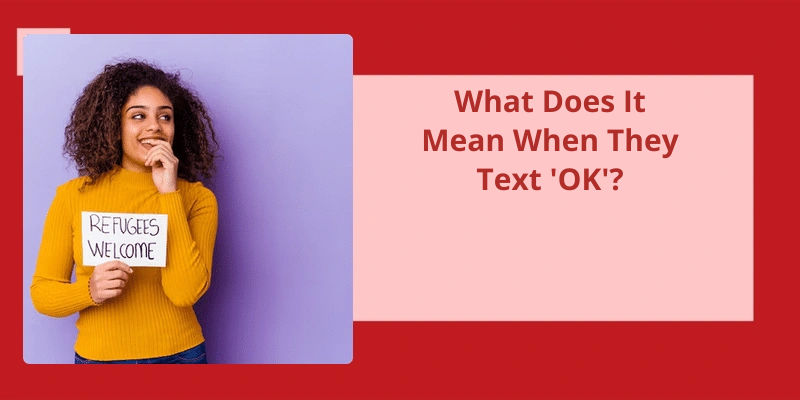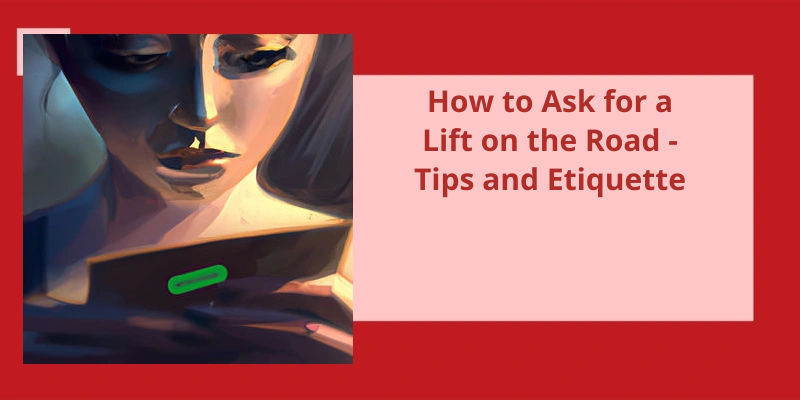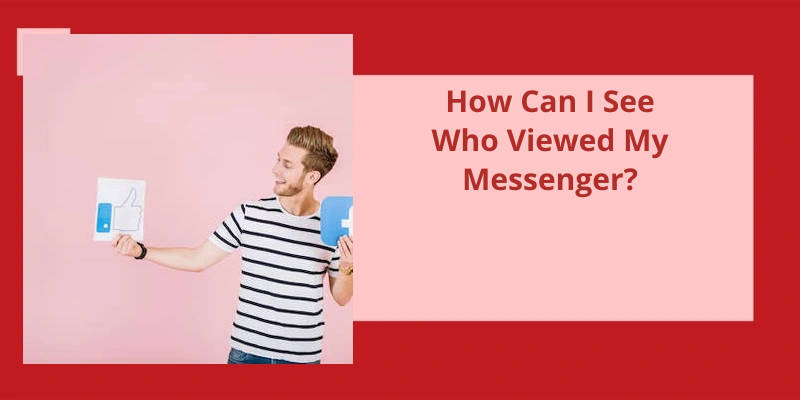When conversing through text messages, deciphering the meaning behind each message can be a daunting task. In particular, receiving a simple "ok" in response to a text message can often leave individuals wondering what the sender truly meant. While "ok" may seem like a straightforward response, it’s meaning can vary greatly depending on the context of the conversation and the relationship between the individuals involved. Some may see it as an informal way of showing agreement, while others may interpret it as a dismissive or indifferent response. In today's digital age, where communication is largely text-based, understanding the implications of such responses is vital for effective communication and avoiding potential misunderstandings.
Is Okay Rude in Text?
The use of the word “okay” in text messaging has become a popular trend for acknowledging the message but it can result in different interpretations depending on the context of the conversation. While some people might see nothing wrong with it, others might consider it as rude or dismissive, particularly when it’s used in inappropriate situations.
In situations where there’s a need for a lengthy or detailed response, using “okay” can be seen as a lack of interest or a lack of thoughtfulness towards the message conveyed. This can result in the other person feeling devalued, unimportant, or ignored altogether.
It can also give the impression of being indifferent, not taking the conversation seriously, or not acknowledging the feelings or emotions behind the message sent. This could trigger negative emotions or even lead to misunderstandings between the two parties involved in the conversation.
It’s often suitable for phone-related conversations or quick updates. But even then, it’s essential to ensure the other person understands the message conveyed and isn’t misinterpreting it.
It isn’t a one-size-fits-all approach, and people should be mindful of how they choose their words to avoid coming off as dismissive. It’s crucial to prioritize the feelings and expectations of the person you’re communicating with to foster a healthy relationship and avoid misunderstandings.
But have you ever wondered why people choose to text “OK” instead of other responses? While the term has been around for over a century, it’s usage has evolved and taken on new meanings in the digital age. From denoting acceptance to simply acknowledging a message, “OK” has become a versatile and popular response in text conversations. But what drives people to choose this particular response over others? Let’s explore the reasons behind our tendency to text “OK.”
Why Do People Text OK?
The use of the word “OK” has become so ingrained in modern society that it’s hard to imagine a time when it wasnt around. It’s a versatile word that can be used to convey many different meanings depending on the context in which it’s used. For example, it can be used to show agreement, approval, or simply to indicate that youve read and understood the message. Despite it’s widespread use, however, the origins of the word are still somewhat shrouded in mystery.
One theory is that “OK” is derived from the Choctaw word “okeh,” which means “it is so.”. This theory originates from the early 19th century when some Choctaw Indians were recruited to serve in the U.S. Army. According to this theory, the word “okeh” became popular among the soldiers and eventually evolved into “OK.”. Another theory suggests that the word is an abbreviation for “oll korrect,” a misspelling of “all correct” that was popularized during the mid-19th century.
It’s used in a variety of settings, from casual conversations among friends to formal business emails. In many ways, it’s become a shorthand way of acknowledging and affirming a message without having to write a lengthy response.
In an age where people are constantly bombarded with information, a short and simple message can be a welcome respite from the noise. It’s also a versatile word that can be easily adapted to suit different situations. For example, adding an exclamation point to “OK!” can give it a more enthusiastic tone, while appending a question mark to “OK?” can indicate uncertainty or a request for clarification.
The Psychology Behind Why People Use “OK” in Their Conversations
- It’s a quick and easy way to acknowledge a message or request.
- It can be used to convey agreement or approval without elaborating further.
- Use of “OK” may be influenced by cultural norms and communication styles.
- Some people use it as a response when they aren’t actually okay with something, but don’t want to cause conflict.
- It can serve as a way to end a conversation or indicate that a topic has been settled.
Now that we’ve established what “OK” means as an abbreviation in a text message, it’s important to note that this small phrase has become a ubiquitous part of digital communication. Whether you’re using Snapchat, WhatsApp, Facebook, Twitter, Instagram, or TikTok, “OK” is likely to be a common sight in your inbox. But why has this two-letter word become such a staple of online communication? Read on to find out more.
What Does OK * Mean in a Text?
When it comes to texting and messaging platforms, there are countless acronyms and shorthand used to express different emotions, opinions, and thoughts. One of the most common phrases youll see is “OK”. While it may seem straightforward, there are actually a few different interpretations of what this common abbreviation means.
This phrase is often used at the end of a message or statement, indicating that the sender was just joking around and not intending to be taken seriously. It’s a lighthearted way of adding some humor to a conversation, while also making it clear that the message shouldnt be taken too seriously.
However, “OK” can also be used as a sign of approval or acceptance. When someone responds to a message with “OK”, theyre essentially saying that they understand the message and are okay with it. It’s a way of acknowledging someone elses message without necessarily offering a full response or additional commentary.
This is often the case when discussing something relatively minor or inconsequential.
From Snapchat to TikTok, youll find this abbreviation used in countless conversations and across multiple social media channels. It’s a quick and easy way to offer a response without taking too much time or energy to craft a longer message.
As we engage in daily conversations, we often come across phrases and expressions that may sound easy to comprehend but carry underlying meanings. One such phrase is “OK fine.” While it may seem like a straightforward agreement, there’s more to it than meets the eye. Let’s delve deeper into what OK then fine means and how it can be interpreted.
What Does OK Then Fine Mean?
When it comes to communicating with others, it’s important to understand the different nuances that can be present in our language. One common phrase that you may hear is “OK then fine”. This phrase is typically used when someone is agreeing to something, but not necessarily with enthusiasm or excitement. Instead, it’s often used in a more defiant or resistant way.
For example, imagine that you’re having a discussion with a friend about where to go for dinner. You suggest your favorite restaurant, but your friend is hesitant. Eventually, they agree with a response like “OK then fine, we can go to that place.”. While they’re technically agreeing to your suggestion, their tone and choice of words indicate that they may not be completely on board with the idea.
There are many reasons why someone might respond in this way. They may be feeling reluctant or hesitant for personal reasons, or they may be expressing frustration or annoyance. It’s important to pay attention to other cues in the conversation, such as nonverbal expressions, to get a better understanding of the speakers overall attitude.
It’s important to note that “OK then fine” isn’t always a negative response. It can also be used in situations where someone is simply being acquiescent or neutral in their response. For example, if someone asks if you want to go to a certain event and you respond with “OK then fine”, this may simply mean that you aren’t particularly invested in the decision, but are still willing to go along with it.
In general, it’s important to be mindful of the words and phrases we use when communicating with others. Even seemingly small nuances, like the choice between “OK” and “great”, can convey a lot of meaning and emotion. By paying attention to these cues, we can develop a deeper understanding of our friends, family, and colleagues, and build stronger relationships based on mutual respect and trust.
Source: What does it mean when a guy says, “Ok fine then”? – Quora
Conclusion
In conclusion, the ubiquitous use of the term "OK" has become a staple in modern communication. It’s origin in American English has lent it to various spelling variations including okay, O.K., ok and Ok. The term signifies acceptance, agreement, assent, acknowledgment, or even indifference, making it a versatile choice for various contexts.






